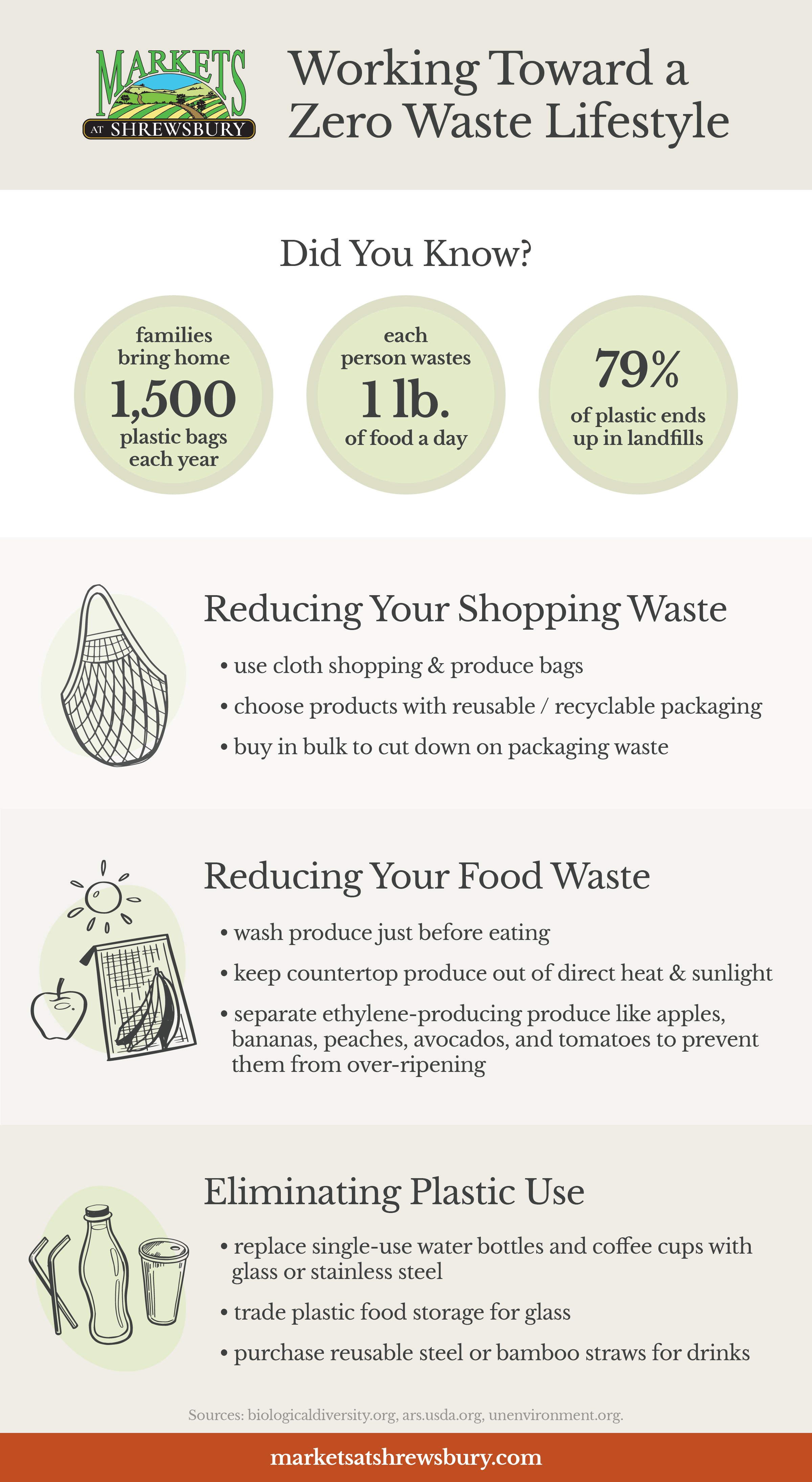You’ve already made the commitment to shop at your local farmers market, which means you’re enjoying the benefits of fresher, healthier foods, playing a role in helping local farmers and growers, and reducing the need for food transportation.
If you made a resolution in the new year to make even bigger strides towards reducfing your ecological footprint, taking the first step can seem overwhelming. Don’t feel like you need to make major transformations or tackle every aspect of your daily living right from the start.
Working towards zero waste is a good place to begin because there are small, easy steps you can take to start living a zero waste lifestyle. Here are three areas you can focus on.

Zero Waste Shopping
One of the best places to start making changes towards a zero waste lifestyle is your weekly food shopping trip. Over the course of a year, the average American family brings home 1,500 plastic shopping bags and only 1% are returned for recycling.
But it’s not just avoiding plastic bags. There are other changes you can make each time you visit your farmers market or grocery store (or other large retail stores) to minimize your wastefulness.
- Use cloth shopping bags and mesh produce bags when you shop at farmers markets and grocery stores, instead of the plastic bags they provide. Return them to your car as soon as you unpack your groceries so you always have them available.
- For bananas, citrus, or other produce with hard skin or rind, you can skip the produce bags entirely.
- Farmers markets often sell their produce in berry baskets that are produced from recycled wood pulp instead of plastic containers.
- Buying bulk food instead of food in smaller quantities reduces the amount of food packaging you dispose of. Your local farmers markets may also let you fill mason jars or other glass or stainless steel containers with your bulk food purchases to eliminate packaging entirely.
- Bag your own groceries in an effort to fit more items in each bag and eliminate your need to use plastic bags.

Explore Our Other Blogs
Entertaining & Holidays– Learn how to host perfect dinners and learn about Amish holiday traditions.
In The Kitchen – Explore how to make the most out of your Market’s produce and food with recipes, tips & tricks, helpful guides.
Shopping At The Markets– Find helpful advice for shopping at a farmers market on anything from FAQs on shopping in bulk or secrets to choosing the best produce.
Reducing Food Waste
Recent reports show that between 2007 and 2014, Americans threw out nearly one pound of food every day. They also show that 39% of the total waste consisted of fruits and vegetables.
The key to reducing food waste, especially produce waste, is to know the best way to store food to maintain maximum freshness. These storage tips will help reduce the number of fruits and vegetables you’ll need to throw away.
- Do not wash all your produce right away. The excess moisture can cause mold. Wait until you’re ready to eat it.
- Bananas, avocados, citrus fruits, peaches, plums, and tomatoes should all be stored on your countertop.
- Remove produce from any bags and keep it out of direct heat or sunlight.
- Store apples, berries, broccoli, cauliflower, carrots, corn, cucumbers, melons, peppers, and summer squash in the refrigerator. Keep the temperature set at 40° F or below.
- Garlic, onions, potatoes, and hard squash should be stored in cool, dry places like a cupboard or pantry.
- Produce like apples, bananas, avocados, peaches, and tomatoes produce high amounts of ethylene gas, which can cause other produce to over ripen. Keep these items separated from others.
Additionally, you need to change your mindset on produce that isn’t perfect. You don’t need to toss it. There are plenty of uses for bruised bananas, wilted greens, or soft berries and tomatoes. Overripe bananas and berries are perfect for breakfast smoothies, in baked goods, and for making jam. Wilted greens can also be used in smoothies, to make a pesto sauce, or simply sautéed with garlic and oil. Soft tomatoes can make a terrific tomato sauce.
Eliminating Plastic
Since the 1950s, more than 83 tons of plastic has been produced, and the rate of production has been faster than any other material. More alarming is the fact that 79% of plastic ends up in landfills, as opposed to being recycled or incinerated. Eliminating your reliance on single-use plastic products, which includes items like drink bottles and bottle caps, food wrappers and packaging, grocery bags, drink lids, straws, and plastic utensils can help to eliminate waste in landfills and oceans and minimize the production of greenhouse gas emissions.
Here are a few easy swaps you can make in your zero waste lifestyle to do your part in reducing the amount of plastic that ends up in our landfill.
- Replace single-use plastic bottles with reusable glass or stainless steel water bottles.
- Use a reusable tumbler for coffee or tea — many coffee shops will even offer a discount if you bring your own reusable container.
- Carry stainless steel straws in your bag for cold and iced drinks.
- At home, replace your plastic Ziploc or Tupperware storage containers with glass containers.
- Choose bar soaps (and even bar shampoos) over toiletries in plastic bottles.
- Mix up a simple household cleaner of water and vinegar instead of buying multiple cleaners in plastic containers. You can also add essential oils for more appealing scents.
For even more tips and trick for going zero waste, we suggest the following social media accounts dedicated to the lifestyle: Going.Zero.Waste, Zero Waste Nerd, and Easy Eco Tips.



